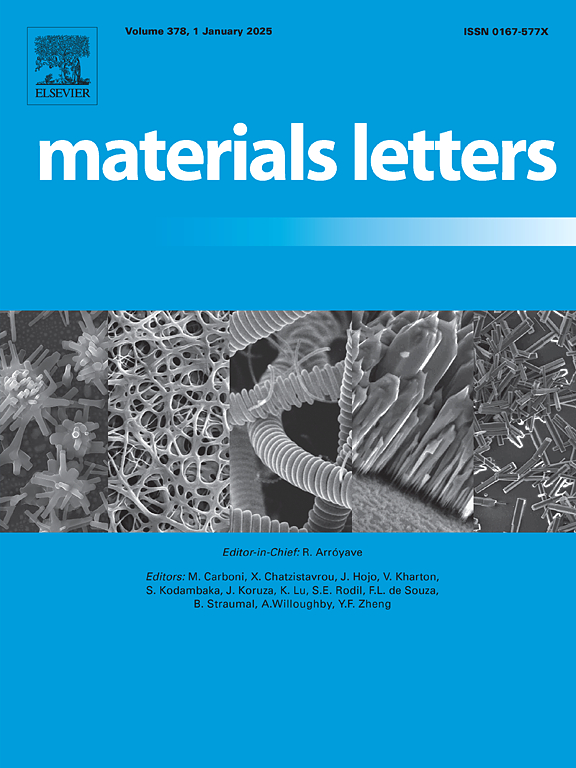通过调整铸锭成分改善激光粉末床熔覆Ti-Zr-Nb合金的超弹性
IF 2.7
4区 材料科学
Q3 MATERIALS SCIENCE, MULTIDISCIPLINARY
引用次数: 0
摘要
本文描述了一种成功实现的用于激光粉末床熔融(LPBF)打印骨科植入物的Ti-Zr-Nb形状记忆合金的化学成分控制方法。结果表明,为了使印品中Ti- 18zr - 15nb (at.%)的含量达到目标,必须调整铸锭成分,使Ti含量提高2.5 %,Zr和Nb含量分别降低1 %和1.5 %。这些修改补偿了粉末雾化和LPBF加工过程中发生的成分变化,并且 - 在550℃下熔融后退火30 min - 后,打印出具有优异室温超弹性的产品:超弹性恢复应变为2.6 %,总恢复应变为6.1 %。所获得的材料力学性能(极限抗拉强度为725 MPa,杨氏模量为53GPa)使本研究的lpbf打印和退火Ti-18Zr-15Nb合金成为骨科植入物的有希望的候选材料。本文章由计算机程序翻译,如有差异,请以英文原文为准。
Improving superelasticity of a laser powder bed-fused Ti-Zr-Nb alloy via the ingot composition adjustments
This paper describes a successfully implemented method for controlling the chemical composition of Ti-Zr-Nb shape memory alloys for laser powder bed fusion (LPBF) printing of orthopedic implants. It is shown that to achieve the target Ti-18Zr-15Nb (at.%) composition in the printed product, the ingot composition must be adjusted by increasing the Ti content by 2.5 % while decreasing the Zr and Nb contents by 1 % and 1.5 %, respectively. These modifications compensate for compositional variations occurring during powder atomization and LPBF processing, and − following a post-fusion annealing at 550℃ for 30 min − result in a printed product with excellent room-temperature superelasticity: a superelastic recovery strain of 2.6 % and a total recovery strain of 6.1 %. The obtained mechanical properties of the material (an ultimate tensile strength of 725 MPa and Young’s modulus of 53GPa) make the LPBF-printed and annealed Ti-18Zr-15Nb alloy of this study a promising candidate for orthopedic implants.
求助全文
通过发布文献求助,成功后即可免费获取论文全文。
去求助
来源期刊

Materials Letters
工程技术-材料科学:综合
CiteScore
5.60
自引率
3.30%
发文量
1948
审稿时长
50 days
期刊介绍:
Materials Letters has an open access mirror journal Materials Letters: X, sharing the same aims and scope, editorial team, submission system and rigorous peer review.
Materials Letters is dedicated to publishing novel, cutting edge reports of broad interest to the materials community. The journal provides a forum for materials scientists and engineers, physicists, and chemists to rapidly communicate on the most important topics in the field of materials.
Contributions include, but are not limited to, a variety of topics such as:
• Materials - Metals and alloys, amorphous solids, ceramics, composites, polymers, semiconductors
• Applications - Structural, opto-electronic, magnetic, medical, MEMS, sensors, smart
• Characterization - Analytical, microscopy, scanning probes, nanoscopic, optical, electrical, magnetic, acoustic, spectroscopic, diffraction
• Novel Materials - Micro and nanostructures (nanowires, nanotubes, nanoparticles), nanocomposites, thin films, superlattices, quantum dots.
• Processing - Crystal growth, thin film processing, sol-gel processing, mechanical processing, assembly, nanocrystalline processing.
• Properties - Mechanical, magnetic, optical, electrical, ferroelectric, thermal, interfacial, transport, thermodynamic
• Synthesis - Quenching, solid state, solidification, solution synthesis, vapor deposition, high pressure, explosive
 求助内容:
求助内容: 应助结果提醒方式:
应助结果提醒方式:


